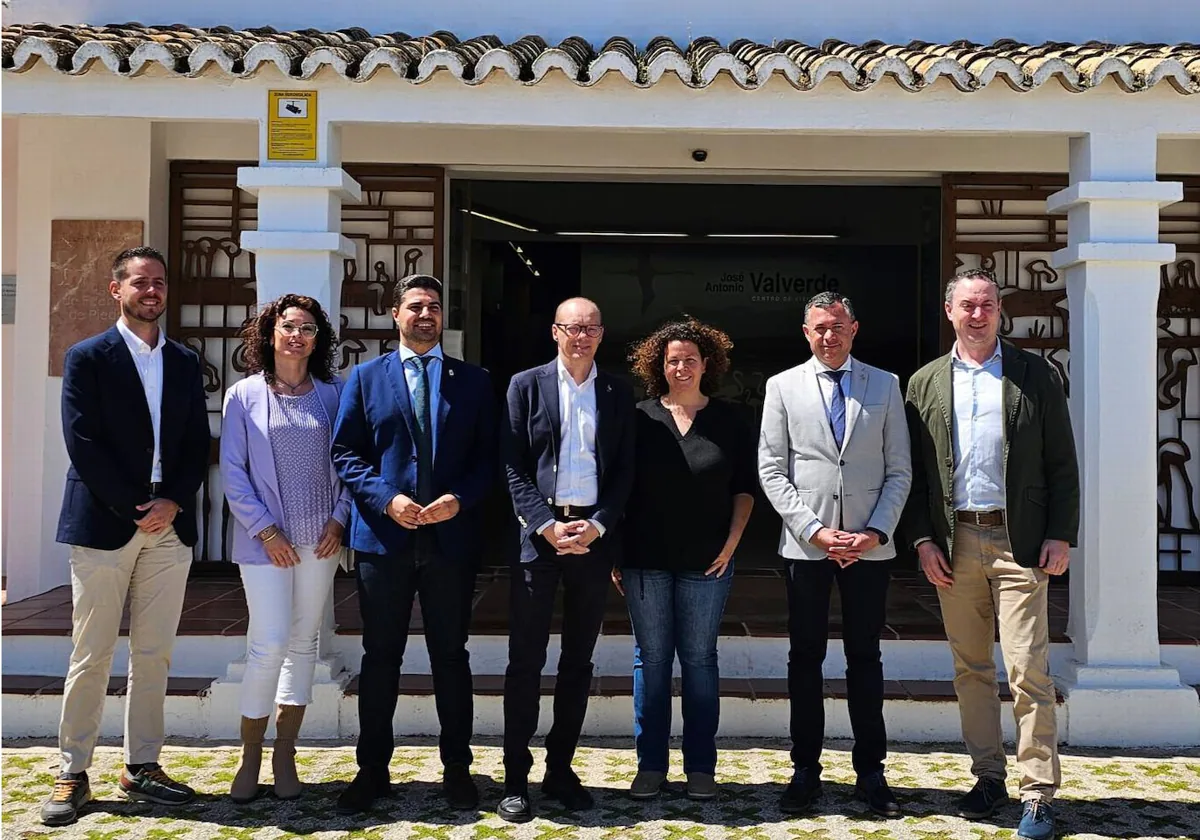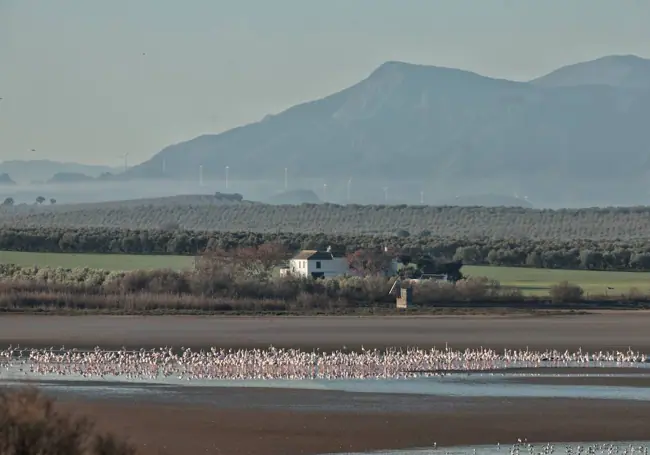Famous Malaga province lake marks 40 years as nature reserve with a flamboyance of more than 8,000 flamingos
Experts have used the occasion to warn that the recent rainfall is not enough to prevent the Laguna de Fuente de Piedra from running dry again, raising serious doubts about the number of birds that might nest this year
La Laguna de Fuente de Piedra celebrated its 40th birthday on 9 January with its sights set on the spring rains, some four decades since its declaration as a protected, ecological nature reserve. At that time the area resembled more a desert than a large wetland. However, after the latest rains in Malaga province it has recovered its traditional appearance. Not just the fact that there is now water in the lake, there is also the pink hue from the flamingos' presence as additional proof that its habitat is in recovery. "The rains have allowed there to be around 8,000 flamingos at the lake and they are attempting to breed," said the reserve's director África Lupión at the anniversary event.

The event, which took place at the José Antonio Valverde visitor centre, was chaired by Director General of Protected Natural Spaces José Enrique Borrallo, Siro Pachón (Fuente de Piedra's mayor), and José Antonio Víquez (regional delegate for Sustainability, Environment and the Blue Economy). Víquez pointed out that this ecological area was the first to be declared a nature reserve in Andalucía: "More than 400,000 flamingos have visited here, rearing more than 7,500 chicks per year". In turn Borrallo mentioned that the figures show that conserving this environment and promoting environmental values is not incompatible with public use and access. In fact, far from it: the socio-economic development of the area has blossomed thanks to visitors generating wealth in the surrounding villages and towns.
Ringing
As for ringing, which resumed in 2022 after a two-year stoppage due to Covid, it was not possible last year as no flamingos were nesting. This year it is still unknown whether it will be possible to do it, it all depends on what falls from the sky. "We won't know until June, but if we are unlucky enough to get no more rain and the lake dries out before June, then we'll know sooner", said Lupión. As such he was acknowledging that the latest rains, despite having brought a flamboyance of flamingos, have not been enough, as only 295mm have fallen since October. "This figure is well below average, which means that if there is no more rainfall, the lake will dry up as that is its nature," he explained.
More than 40 different species
After a winter of low rainfall the lake has welcomed a remarkable number of birds to its waters. Actually, the census carried out last week put the figures at 10,865 waterfowl in total, making up 44 different species when counting both those at the lagoon (30 species present) and the surrounding wetlands on its perimeter where there are trails and hides for public use. The common flamingo is the most numerous specie with more than 8,000 birds, of which around 4,900 have begun nesting on the central island of Senra within the lake. The other two species that form colonies in the lagoon, black-billed guillemots and black-headed gulls, numbering 643 and 234 respectively, have also begun to occupy their breeding sites.
However, the water level - only about 27 centimetres deep on Tuesday last week - is somewhat below what is considered necessary for the colonies to remain for the breeding season. The weather over the next few weeks will determine whether this is a successful breeding cycle or not. If it does not rain, then the lake will begin its natural process of drying out as the higher-than-average spring temperatures, together with the wind, will accelerate evaporation, leading to the possibility of nests being abandoned. Including 2023, this makes seven years in which the flamingos have not attempted to breed.
Major site for ornithologists
Víquez explained how La Laguna de Fuente de Piedra has become a major site for ornithologists, not only in Andalucía and Spain, but also for the southern Mediterranean area, "even at European and world levels", he said. For this reason, he said that the regional government is investing more to improve biodiversity across all the lakes in Andalucía. The investment stands at more than 800,000 euros to ensure that some 230 of the 638 species of animals, especially birds, catalogued in Spain and which are present in this area, continue to remain here. In addition to the pink flamingo, some thirty species of waterfowl nest in the lake, "this wetland area is the only one in the province where waterfowl have managed to reproduce this last hydrological year [rain cycle: Sept-Aug] thanks to 'El Laguneto', a small lake that is maintained all year round thanks to purified water from the town's mains supply", stated Lupión.
This year the reserve is involved in the project entitled 'Habitat Restoration and Conservation of the Protected Wetlands of Malaga'. This started with clearing, pruning and chopping down the tamarisk trees in 'los Juncares', a shallow water area bordering the main access road to the lake. This action, carried out by Empresa Pública de Transformación Agraria with a budget of 920,000 euros, is the first of several planned actions, such as the cleaning and clearing of water channels and replacement of the perimeter fencing, according to Víquez.
Anniversary activities
To mark the 40th anniversary of the founding of this nature reserve, a programme of activities has been organised to run throughout the year. The first of these was a photography competition with the theme being the reserve itself. Prizes were awarded last Friday at the commemorative event. The 20 selected photographs will be on display at the Visitor Centre until the 21st of this month, the same day on which the prizes for the wetland-themed drawing competition for local schoolchildren, also on display at the centre, will be presented to the principal staff of San Ignacio school in Fuente de Piedra.
At the end of this month (26 April) there will be a scientific conference, organised in collaboration with the International University of Andalucía (UNIA) and the International Union for Conservation of Nature (IUCN). The UNIA-IUCN will be held at the university's city campus in Malaga Port with a series of conference talks on research carried out on the lake plus a round-table discussion.
Next up is a call for proposals for conservation projects being made this month with a maximum budget of 10,000 euros. From the proposals submitted, between one and three projects will be selected to go live during 2024.
Activities aimed more at the residents of Fuente de Piedra include night-sky observation dates scheduled for this summer, as well as volunteering for environmental work to make some changes to the islands of Senra and San Luis within the wetlands, scheduled to be done between August and September. Finally, in the last quarter of the year, actions will be developed to promote good environmental practices in the agricultural sector, as almost all of what lies beyond the protected area of the reserve is used for olive production and livestock farming.

